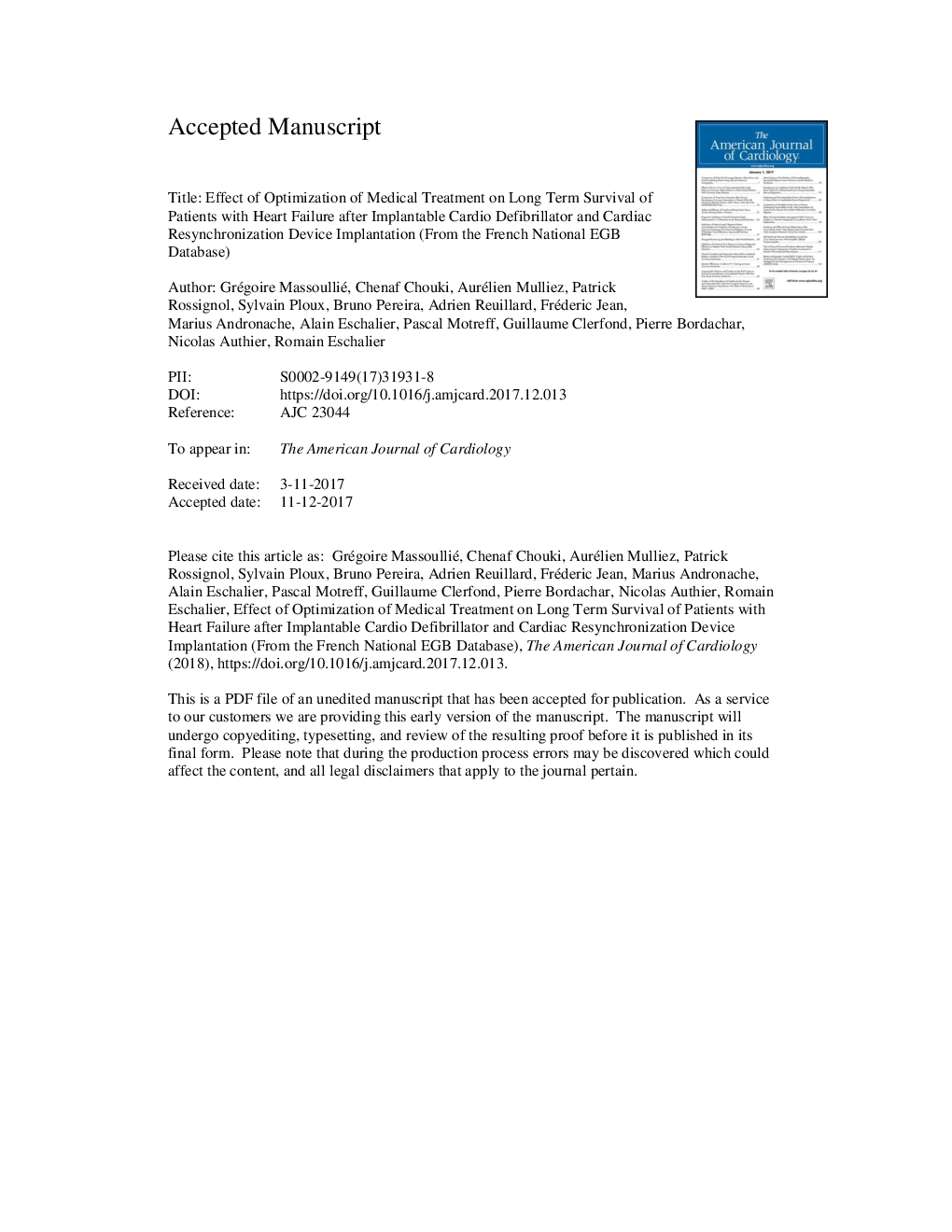| کد مقاله | کد نشریه | سال انتشار | مقاله انگلیسی | نسخه تمام متن |
|---|---|---|---|---|
| 8651471 | 1572065 | 2018 | 27 صفحه PDF | دانلود رایگان |
عنوان انگلیسی مقاله ISI
Effect of Optimization of Medical Treatment on Long-Term Survival of Patients With Heart Failure After Implantable Cardioverter Defibrillator and Cardiac Resynchronization Device Implantation (from the French National EGB Database)
دانلود مقاله + سفارش ترجمه
دانلود مقاله ISI انگلیسی
رایگان برای ایرانیان
موضوعات مرتبط
علوم پزشکی و سلامت
پزشکی و دندانپزشکی
کاردیولوژی و پزشکی قلب و عروق
پیش نمایش صفحه اول مقاله

چکیده انگلیسی
Prognosis of heart failure with reduced ejection fraction (HFrEF) is improved by drug optimization according to guidelines; however, little is known regarding such optimization in HFrEF patients with an implantable cardioverter defibrillator (ICD) or cardiac resynchronization therapy (CRT). This study aimed to describe implementation of this optimized strategy and its impact in patients implanted with an ICD/CRT. Using a 1/97th representative sample of the French national health-care insurance system claims database, a retrospective cohort study was conducted including HFrEF patients implanted with ICD or CRT between January 2009 and December 2014. HFrEF treatments were analyzed before and after ICD/CRT implantation. Heart failure (HF) hospitalization and survival were examined at 1, 3, and 5 years: 378 patients (135 CRT, 243 ICD) with a mean age of 68â±â13 years were included. Mean follow-up was 23 months [11-42]. At baseline, 36% of patients had no or only 1 HFrEF drug among β-blockers, angiotensin-converting enzyme inhibitors or angiotensin receptor blockers, and mineralocorticoid receptor antagonists, whereas 26% of patients received an optimal treatment (all 3 classes). At 3 months after ICD/CRT implantation, the prescription rate of HFrEF drugs was higher than baseline but returned to preimplantation levels at the end of follow-up. HF hospitalization rate was higher in the nonoptimized patient group (28% vs 14%, pâ=â0.001). Optimal HFrEF treatment was associated with better survival (hazard ratioâ=â0.59 [0.4-0.86], pâ=â0.006). In conclusion, HFrEF drugs are underprescribed before and after ICD/CRT implantation despite the demonstration that HFrEF drug optimization also reduces death and HF hospitalization in this population.
ناشر
Database: Elsevier - ScienceDirect (ساینس دایرکت)
Journal: The American Journal of Cardiology - Volume 121, Issue 6, 15 March 2018, Pages 725-730
Journal: The American Journal of Cardiology - Volume 121, Issue 6, 15 March 2018, Pages 725-730
نویسندگان
Grégoire MD, Chenaf MD, PhD, Aurélien MSc, Patrick MD, PhD, Sylvain MD, PhD, Bruno PhD, Adrien MD, Fréderic MD, Marius MD, PhD, Alain MD, PhD, Pascal MD, PhD, Guillaume MD, Pierre MD, PhD, Nicolas MD, PhD, Romain MD, PhD,